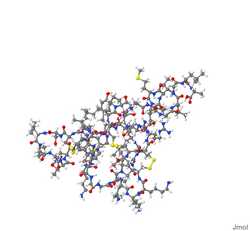(diff) ← Older revision | Latest revision (diff) | Newer revision → (diff)
Short description: Family of toxins produced by spiders
Spider toxins are a family of proteins produced by spiders which function as neurotoxins. The mechanism of many spider toxins is through blockage of calcium channels.
A remotely related group of atracotoxins operate by opening sodium channels. Delta atracotoxin from the venom of the Sydney funnel-web spider produces potentially fatal neurotoxic symptoms in primates by slowing the inactivation of voltage-gated sodium channels.[2] The structure of atracotoxin comprises a core beta region containing a triple-stranded a thumb-like extension protruding from the beta region and a C-terminal helix. The beta region contains a cystine knot motif, a feature seen in other neurotoxic polypeptides[2] and other spider toxins, of the CSTX family.
Spider potassium channel inhibitory toxins is another group of spider toxins. A representative of this group is hanatoxin, a 35 amino acid peptide toxin which was isolated from Chilean rose tarantula (Grammostola rosea, syn. G. spatulata) venom. It inhibits the drk1 voltage-gated potassium channel by altering the energetics of gating.[3] See also Huwentoxin-1.[4]
See also
References
Further reading
- "Three-dimensional solution structure of the calcium channel antagonist omega-agatoxin IVA: consensus molecular folding of calcium channel blockers". J. Mol. Biol. 250 (5): 659–71. July 1995. doi:10.1006/jmbi.1995.0406. PMID 7623383.
 | Original source: https://en.wikipedia.org/wiki/Spider toxin. Read more |



